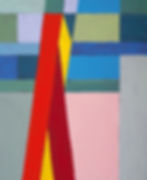
Ever wonder why kids hang on to their teddy bears, binkies, blankies, etc. for so long? Have you ever wondered why they don't understand a story you've told them? It's all because kids are touchy-feely! Children do not actually understand abstract ideas until around age 8. They will be able to pay lip service to something abstract earlier, but most don't actually understand the concepts.

Abstract is not just for art. Abstract means that something is a concept, an idea, a thought; it's something we believe in or know to be a fact, but is not something that can be seen. The results may be seeable but not the facts themselves. Some great abstracts are God, wind, and charm. Children won't understand this abstractness about a concept until they've learned to understand that an "idea" is a concept.

We start teaching children to write at 4, 5, or 6, and they eventually learn to draw the connections between the written words and the spoken words. They learn to write by mimicking what you've written down on paper. But it's hard to get a child to write a whole sentence in the first grade. It takes practice on the child's part and patience on the teacher's or parent’s part. After weeks and months of practice, the concept of connecting all those written words together into an understandable string of words called a "sentence" actually gels in the child's mind. The same is true for trying to teach children in the lower grades how to write paragraphs and essays.
A paragraph is more or less a structured concept that adults have created, stringing several of those "nebulous" sentences together into a collective thought, a concept, an abstract. A young child, who has enough trouble trying to understand what the purpose of a sentence is, will have even more trouble understanding the purpose of a paragraph because it's an abstract concept.

Draw the connection between those sentences and something CONCRETE that the child can see and touch and feel, and you finally have an abstract CONCEPT that the child can see and therefore understand. Numbers are a concept and idea in our heads. Numerals, on the other hand (5, 8,

43) are the concrete version that we can see, so we use numerals to explain, on paper, the idea of adding and subtracting numbers. With numerals (or blocks or hash marks drawn on a paper), the student can see the concept he/she is trying to portray and understand.
Parents, teachers, and the community in general need to learn why it is so hard for children to try and learn certain abstract concepts. We, as parents and teachers, have created ad infinitum different ways/formulae/rubrics to get children to write paragraphs and essays. Most of those rubrics don't work with younger children because they are TOO HARD to learn. They are concepts, abstract and nebulous, that a child can mimic but won't truly understand until they are old enough to understand abstracts. Children (even some high school students) need something simple, something easy to remember, something visual that they can touch and feel, that they can use as a tactile reminder of what that concept is all about. The words "paragraph" and "essay" are abstract concepts. The use of something visual and tactile will turn those abstract concepts into something concrete that a child can understand, usually better, faster and more permanently, than other concepts.

Enter the hand. With five fingers on a hand and five sentences in a paragraph, a child has something visual that he/she can look at and manipulate. Using this concrete device the child will eventually be able to draw the connection between the idea of a paragraph or essay and the written, concrete version of that idea. Use your hand as the concrete manipulative, or find a curriculum that does, to turn the abstract idea into a concrete one from from which your student can learn.

